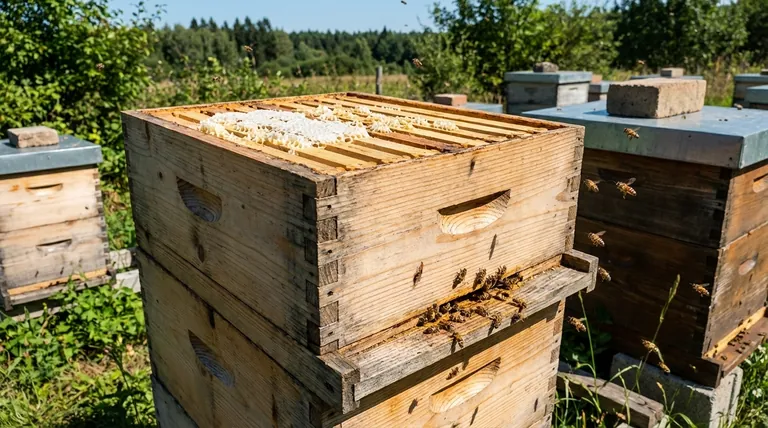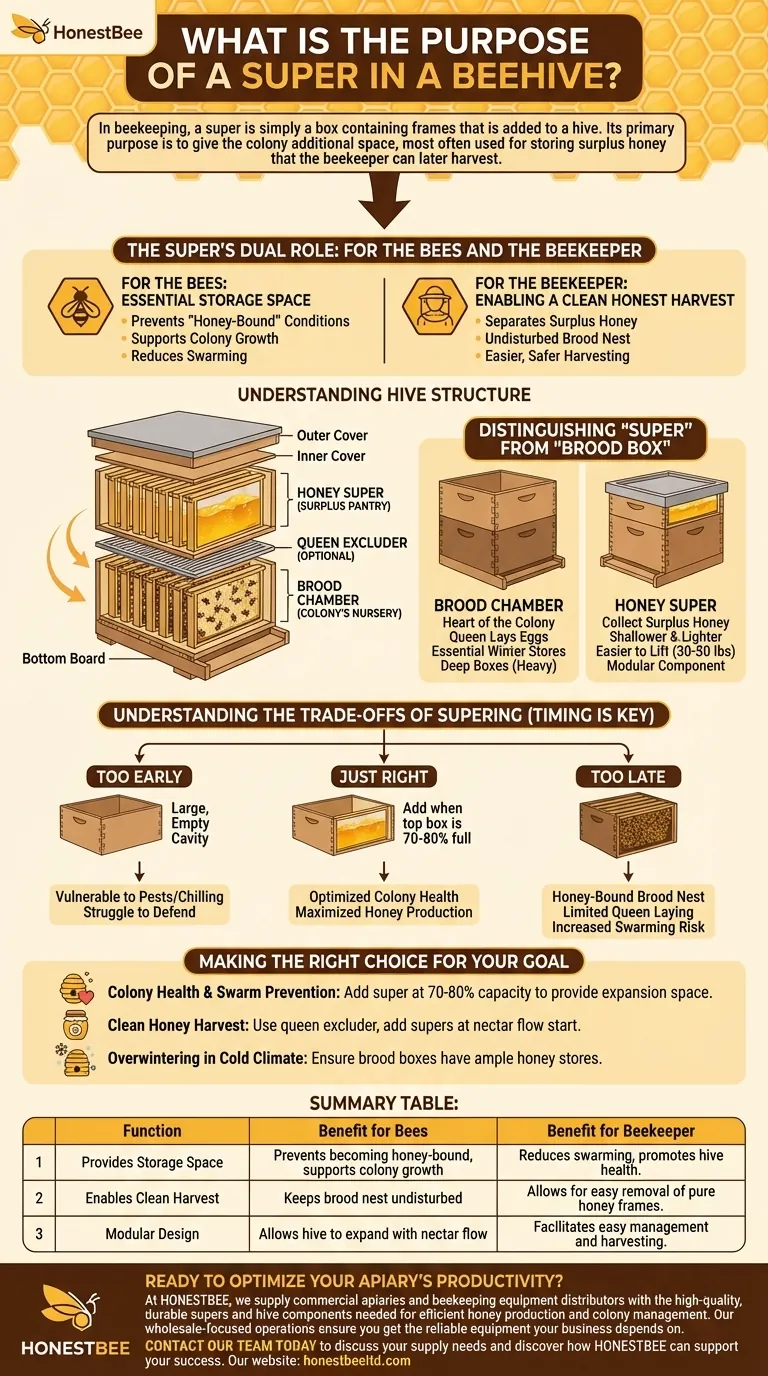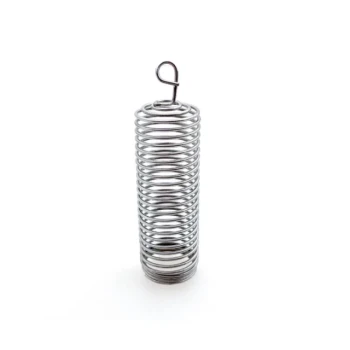In beekeeping, a super is simply a box containing frames that is added to a hive. Its primary purpose is to give the colony additional space, most often used for storing surplus honey that the beekeeper can later harvest. Supers are typically placed on top of the main hive body, or brood chamber, especially during periods of high nectar flow.
A beehive super is best understood not just as a piece of equipment, but as a management tool. It allows a beekeeper to strategically expand the hive's pantry, separating the colony's essential living quarters from the surplus honey designated for harvest.

The Super's Dual Role: For the Bees and the Beekeeper
A super serves two critical functions that benefit both the health of the colony and the goals of the beekeeper.
Providing Essential Storage Space
During a strong nectar flow, bees can quickly run out of room. A super provides the necessary empty space for them to store this incoming nectar and process it into honey.
Without this extra room, the bees might store honey in the brood chamber, a condition known as being "honey-bound." This reduces the space available for the queen to lay eggs, which can limit colony growth and even trigger a swarm.
Enabling a Clean Honey Harvest
The most common strategy in beekeeping is to separate the hive into two zones: the lower brood boxes for raising young bees and the upper honey supers for storing surplus honey.
This separation allows the beekeeper to remove frames of pure honey from the supers without disturbing the crucial brood nest below. This makes the harvesting process cleaner, safer, and far less disruptive to the colony's life cycle.
Understanding Hive Structure
The super is a modular component of the hive. It is placed on top of the brood chamber but sits beneath the inner cover. This inner cover provides an insulating air gap and prevents the bees from sealing the main roof directly to the super.
Distinguishing "Super" from "Brood Box"
While any box added to a hive can technically be called a "superstructure," beekeepers use specific terms to differentiate their functions based on size and location.
The Brood Chamber: The Colony's Nursery
The bottom boxes of the hive make up the brood chamber. This is the heart of the colony where the queen lays eggs and the bees raise their young.
These boxes also hold the essential honey and pollen stores the bees need to survive the winter. They are often "deep" boxes to provide ample space for the colony's core functions.
The Honey Super: The Surplus Pantry
The boxes placed above the brood chamber specifically to collect surplus honey are what beekeepers typically call honey supers.
These are often shallower and lighter than deep brood boxes. A shallow or medium super full of honey can weigh 30-50 pounds, making it much easier for a beekeeper to lift and handle compared to a deep box that could exceed 80 pounds.
Understanding the Trade-offs of Supering
Adding a super, known as "supering," is a matter of timing. Getting it wrong can have negative consequences for the hive.
The Risk of Adding a Super Too Early
If you add a super to a small or weak colony before they are ready, you create a large, empty cavity. The colony may struggle to heat, patrol, and defend this excess space, making them more vulnerable to pests and chilling.
The Consequence of Adding a Super Too Late
If you wait too long, the hive will run out of space during a nectar flow. As mentioned, this can lead to a honey-bound brood nest and can be a primary trigger for the colony to swarm, causing you to lose a significant portion of your bees.
The Queen Excluder Debate
To ensure honey supers remain free of eggs and brood, some beekeepers place a queen excluder between the brood chamber and the honey supers. This is a grid with gaps large enough for worker bees to pass through but too small for the larger queen.
The trade-off is that some believe it can slightly hinder worker bee traffic, potentially slowing down honey production. Using one is a choice based on your management style.
Making the Right Choice for Your Goal
Properly timing the addition of a super is a key skill in proactive beekeeping. Your primary objective will guide your strategy.
- If your primary focus is colony health and swarm prevention: Add a super when the bees have filled 70-80% of the frames in their top-most box to give them expansion space just before they feel crowded.
- If your primary focus is a clean honey harvest: Use a queen excluder and add honey supers just as the main nectar flow begins to encourage the bees to store all surplus honey above the brood nest.
- If your primary focus is overwintering a colony in a cold climate: Ensure the brood boxes themselves have ample honey stores, as this is the food they will rely on, not the honey in the supers you plan to harvest.
Understanding the purpose of a super transforms it from a simple box into a powerful tool for managing your colony's growth and productivity.
Summary Table:
| Function | Benefit for Bees | Benefit for Beekeeper |
|---|---|---|
| Provides Storage Space | Prevents becoming honey-bound, supports colony growth | Reduces swarming, promotes hive health |
| Enables Clean Harvest | Keeps brood nest undisturbed | Allows for easy removal of pure honey frames |
| Modular Design | Allows hive to expand with nectar flow | Facilitates easy management and harvesting |
Ready to optimize your apiary's productivity?
At HONESTBEE, we supply commercial apiaries and beekeeping equipment distributors with the high-quality, durable supers and hive components needed for efficient honey production and colony management. Our wholesale-focused operations ensure you get the reliable equipment your business depends on.
Contact our team today to discuss your supply needs and discover how HONESTBEE can support your success.
Visual Guide

Related Products
- Langstroth Honey Bee Box Hive Boxes for Different Depths
- Australian Langstroth Beehive Boxes for Beekeeping Wholesales
- Professional 500g Sectional Comb Honey Frame System for Beekeeping
- Portable Bee Mating Hive Boxes Mini Mating Nucs 8 Frames for Queen Rearing
- Automatic Heat Preservation 6 Frame Pro Nuc Box for Honey Bee Queen Mating
People Also Ask
- What are the sizes available for Langstroth boxes? A Guide to 8-Frame vs. 10-Frame & Depths
- What are the sizes of supers available in a standard hive? A Guide to Deep, Medium, and Shallow Boxes
- How should hive boxes be aligned after reassembly? Ensure a Perfect Seal for Hive Health
- What factors should beekeepers consider when choosing between wooden and polystyrene hives? Maximize Bee Health and Honey Production
- What is the purpose of the boxes in a Langstroth hive? A Guide to Modular Beekeeping Success



















